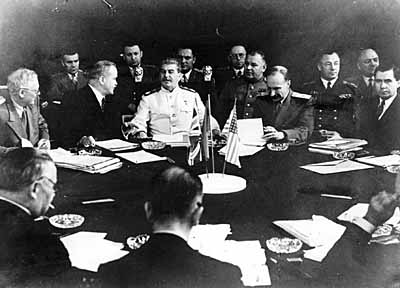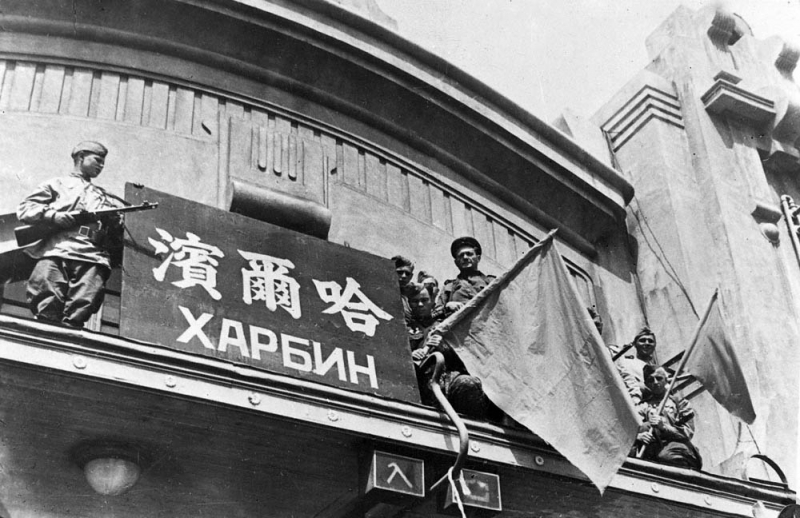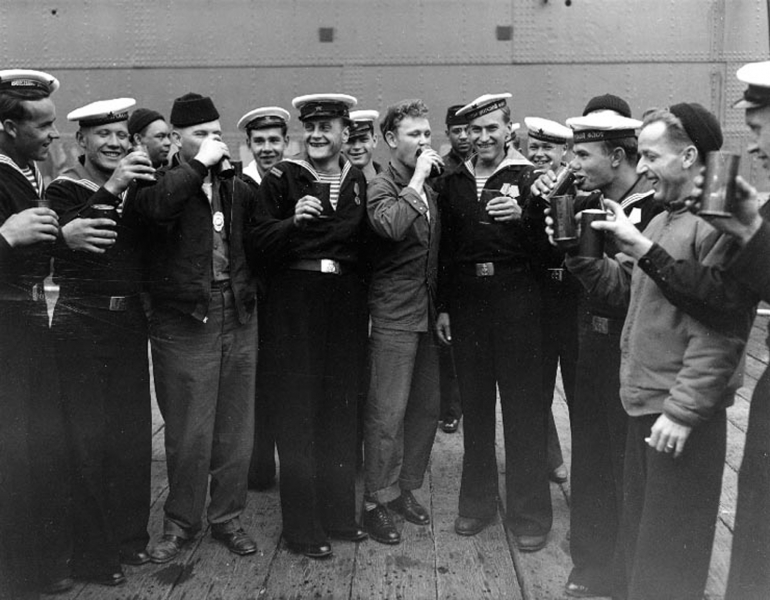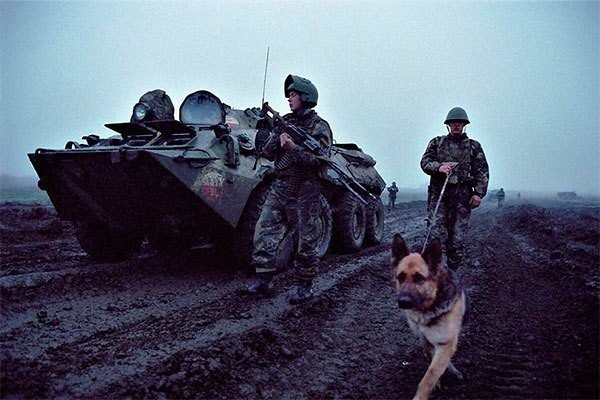
Stalin VI, VM Molotov, AY Wyszynski. and others. members of the Soviet delegation during a meeting of the Potsdam Conference
8 August 2015 year marks the 70 years since, as the Soviet Union entered the war against Japan. But before that, 6 July on behalf of the heads of governments of Great Britain, US and China published the Potsdam Declaration, It contains requirements related to the surrender of Japan. The Japanese government rejected this trebovanie.Nekotorye officers of the General Staff of the Imperial army expected Soviet invasion in late August, other employees of the research department, in Tokyo, and in Changchun, We talked about the probability of the occurrence of early autumn, perhaps, then, and when US forces attacked Japan. A number of officers still hoped, that the Soviet Union would keep its commitments under the treaty of neutrality by 1941 of the year, whose term expires in April 1946 goda.Mezhdu the Japanese troops retreated under the onslaught of American air strikes and naval forces, and almost all the major urban and industrial centers of the metropolis were destroyed. morning 6 August 1945 the year the sky rose bomber B-29 "Superfortress", that his commander Colonel Tibbets named "Enola Gay" - in honor of his mother. It was in that plane was the first uranium bomb "Little Boy" power 20 kilotonn. AT 8 hours 14 minutes 15 seconds Colonel Tibbets gave the order to open the flap "Enola Gay" bomb hatch. The first atomic bomb wiped out Hiroshima, in seconds, killing more than 100 thousand. human. However, the Japanese command even after such a show of force not announced kapitulyatsii.8 August the Soviet Union declared war on Japan, a 9 August sky once stood bomber B-29, He called their commander, Major Sweeney "Great Artist". The bomb bay of the airplane was the second atomic bomb, nicknamed "Fat Man". The main objective of the bombing - the city of Kokura - was hidden by clouds. Major turned to an alternate goal. So the fate of the Nagasaki was solved. The explosion killed about 73 thousand. human, and soon from radiation injuries and died about another 35 thousand.

Harbin, occupied by Soviet troops
As for the causes of the USSR entered the war, then in addition to treaty obligation, the Soviet Union, there were other reasons, forced him to join the war. First of all, it was necessary to ensure the security of its Far Eastern borders. Japan until the end of 1943 , the planned attack on the USSR and the seizure of its territory to the meridian of Omsk, that was more 2/3 the total area of the Soviet Union. Systematically violated the Soviet-Japanese Neutrality Pact. It should be emphasized, that in four years the Japanese warships about 200 time to stop and search the Soviet trade and fishing vessels, some were taken away in their ports, a 18 - drowned. In the Soviet Far Eastern border is over millions grouping of troops, prepared for the attack on the USSR. The basis of the group was the Kwantung Army, which created the need for the war against Germany to keep the Far East by 32 to 59 divisions of ground troops and from 10 to 29 air divisions, about 1 million. personnel, 8-16 thousand. guns and mortars, over 2 thousand. Tanks and self-propelled guns, 3-4 thousand. combat aircraft, more 100 warships. In different periods of the war in the Far East was on 15 to 30 % Soviet armed forces. Besides, As an ally of Germany, Japan throughout the war it provided political and economic support, supplied intelligence information, supplying strategic raw materials, provided its naval base for German submarines. In this way, entering the war against Japan, The Soviet Union was pursuing fair targets: bring an end to the Second World War, secure their Far Eastern borders, regain territory, previously captured by Japan in Russia; help the people of Southeast Asia in their struggle for national independence, meet its obligations to its allies.
From May to July 1945 year from the West to the Far East and Trans-Baikal were transferred to a distance 9-11 thousand km of a large number of troops, especially mobile compounds. The main stream relocations began in May 1945 of the year. Total airlifted: 403 thousand. People l / s, 7 137 guns and mortars, 2 119 Tanks and self-propelled guns, 17 374 Car, 1,5 thousand. tractors and trucks.
The Soviet troops: Transbaikal front (Marshal RY. Malinowski), 1-th Far East (Marshal KA. Meretskov), 2-th Far East (Army Gen. MA. Purkayev). Also involved the Pacific Fleet and the Red Banner Amur Flotilla. General guidance operation: The High Command of the Soviet troops in the Far East (CINC - Marshal AM. Wasilewski).

Soviet and American sailors celebrate Japan's surrender
The plan of operations was as follows: by the troops of the Trans-Baikal, 1-st and 2nd Far Eastern fronts to carry out a rapid invasion of Manchuria in depth in all three strategic areas, inflicting major strikes from the territory of the Mongolian People's Republic to the east and to the Soviet Primorye west; master the most important military-political and economic centers of Mukden, Changchun, Harbin, Jilin; divide the main grouping of the Kwantung Army troops in two parts, surround them and destroy successively in Northern and Central Manchuria. The leading role in the operation was assigned to the Trans-Baikal and the 1st Far Eastern Front, which should have been main attack on a converging path to Changchun.
The defeat of militarist Japan in a short time was only possible due to the defeat of the located in the Kwantung Army in Manchuria. Based on this, Soviet High Command has developed a strategic action plan, which included the destruction of the main forces of the Japanese land forces actions strike groups Transbaikalian, 1-st and 2nd Far Eastern fronts.
Night 9 August, the Red Army attacked the enemy positions, - started Manchurian Strategic Offensive Operation, which was attended by troops of the Transbaikal Front of the 1st and 2nd Far Eastern fronts and the Mongolian People's Revolutionary Army, in cooperation with the Pacific Fleet and the Amur Flotilla. After a powerful artillery barrage and bombing Soviet forces broke through the defenses of the Japanese, and began a rapid advance deep into Manchuria. Resistance has only a special defensive units. For five days the troops have advanced on the Trans-Baikal Front 250-400 kilometers. But similar rates of occurrence were not everywhere. The Japanese fought to the last, soldiers bombers were active, throws a grenade attached to a belt or a mine under the tank. Particularly strong enemy resistance exerted in the zone of advance 1st Far East Front. 16 August, Soviet troops entered the territory of Korea. As a result, the Manchurian operation Soviet troops routed the Kwantung Army, liberated Manchuria, part of North China and North Korea (to the 38th Parallel). Soviet troops had yet to hold the South Sakhalin and the Kuril landing operation.
Gabriel Tsobehiya











